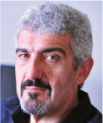Editorial
Curt WentrupEditor-in-Chief, Australian Journal of Chemistry, School of Chemistry and Molecular Biosciences, The University of Queensland, Brisbane, Qld 4072, Australia. Email: wentrup@uq.edu.au

Curt Wentrup was educated at the University of Copenhagen (Cand. Scient. 1966; D.Sc. 1976) and the Australian National University (Ph.D. 1969). He held an assistant professorship at the Université de Lausanne, Switzerland, and a professorship at the Universität Marburg, Germany, before returning to Australia in 1985 as Professor and Chair of Organic Chemistry and head of the organic chemistry section at the University of Queensland, where he is now emeritus professor. Since 2009, he has been Chair of the National Committee for Chemistry at the Australian Academy of Science. He is a Fellow of the Australian Academy of Science and has published over 300 research papers. His research interests are in the fields of both experimental and computational chemistry of reactive intermediates and unusual molecules, flash vacuum thermolysis, and photochemistry, and he collaborates extensively with groups in Denmark, France, Germany, Singapore, and Switzerland. |

Margaret Brimble is Professor of Organic Chemistry in the School of Chemical Sciences and Institute for Innovation in Biotechnology at the University of Auckland, New Zealand. She graduated M.Sc. from the University of Auckland in 1983 and was awarded a UK Commonwealth Scholarship to undertake her Ph.D. studies at Southampton University, UK. In 1986, she was appointed as a lecturer at Massey University. After a Visiting Professorship at the University of California, Berkeley, she moved to the University of Sydney in 1995 as a Reader in Organic Chemistry before returning to New Zealand in 1999 to take up the Chair of Organic Chemistry at the University of Auckland. She established New Zealand’s first B.Sc. (Hons) degree in medicinal chemistry and has been Director of the Medicinal Chemistry Programme since 2002. Her research focuses on the synthesis of novel bioactive natural products (especially molecules derived from extreme environments and shellfish toxins) as novel anticancer, antibacterial, and antiviral agents, peptides and peptidomimetics for the treatment of neurodegenerative disorders, and the synthesis of peptide components for melanoma vaccines. She is Chairperson of the Rutherford Foundation Board of Trustees, Principal Investigator of the Maurice Wilkins Centre for Molecular Biodiscovery, Titular Member of the IUPAC Organic and Biomolecular Chemistry Division, and a member of the international advisory boards for several international journals. She is a member of the Marsden Fund Council and past president of the International Society of Heterocyclic Chemistry. In 2004, Margaret Brimble became a Member of the New Zealand Order of Merit (MNZM). She was named the 2007 L'Oréal-UNESCO Women in Science Laureate for Asia-Pacific in materials science, and was the recipient of the 2010 Natural Product Chemistry Award from the Royal Society of Chemistry. |

Richard Hoogenboom is Associate Professor of Supramolecular Chemistry at Universiteit Gent, Belgium. He obtained his M.Sc. and Ph.D. degrees from the Eindhoven University of Technology, the Netherlands, in 2001 and 2005. After working as a project leader at the Dutch Polymer Institute with Professor Ulrich S. Schubert (2005–2008), he joined Professor Martin Möller's group at the RWTH Aachen (Germany) as an Alexander von Humboldt postdoctoral fellow. During 2009–2010, he was a senior postdoctoral researcher in the group led by Professor Roeland J. M. Nolte at the Radboud University Nijmegen before accepting his present position at Ghent University. He has published ~200 refereed papers and 10 book chapters, and he has been a guest editor for Aust. J. Chem. He is a member of the editorial boards of Reactive and Functional Polymers, Journal of Functional Biomaterials, Macromolecular Rapid Communications, and the European Polymer Journal. His research interests are in poly(2-oxazoline)s, responsive polymers, and supramolecular polymers. |

George Koutsantonis is a synthetic chemist with an interest in functional materials that contain metals. He is a graduate of the University of Adelaide, where he obtained his B.Sc. (Hons) and Ph.D. degrees, the latter under the supervision of Michael Bruce. He began his scientific career studying the coordination properties and reactions of alkynes and often returns to conduct research in this fascinating area. He undertook a postdoctoral position at the University of Kentucky, Lexington, where he continued his work with alkynes, more specifically investigating metathesis reactions with metalloalkynes. After a fruitful period in the USA, he returned to Australia on an inaugural ARC Postdoctoral Fellowship at Griffith University in 1991. In Brisbane, still essentially an inorganic chemist, he worked with Main Group hydrides of Group 13. He was appointed to the staff at the University of Western Australia in 1995, where he is now Professor. In Perth, he established an independent research program in organometallic and inorganic chemistry. His work in this area was recognised by the joint receipt of the RACI Organometallic Award in 2004. He is a member of the RACI Inorganic Division Committee and a member of the RACI Board as the Western Representative. He is an enthusiastic amateur cabinetmaker and has, for many years, exhibited purebred German Shorthaired Pointers under the Dürers prefix. |

Devon A. Shipp hails from northern Victoria. He completed a B.Sc. (Hons) in chemistry (1993), followed by a Ph.D. (1998) at the University of Melbourne under the supervision of Professor David Solomon, Dr Graeme Moad, and Dr Trevor Smith, studying radical polymerisation kinetics via pulsed laser photolysis methods. He then accepted the Bayer Postdoctoral Research Fellowship at Carnegie Mellon University (Pittsburgh, Pennsylvania), and worked with Professor Kris Matyjaszewski, who had just developed atom transfer radical polymerization (ATRP). After almost two years at CMU, he became Assistant Professor at Clarkson University in northern New York State, where he took up teaching and research in organic and materials chemistry. He was subsequently promoted to Associate Professor and then Professor. He continues to use ATRP, along with reversible addition-fragmentation chain transfer (RAFT) polymerization and thiol-ene polymerizations, in his research on polymer nanocomposites, block copolymers, and synthesis of surface-eroding (biodegradable) polymers. He is the author and co-author of ~40 peer-reviewed papers, several patents/patent applications, and several book/encyclopaedia chapters, and was guest editor of a recent special edition of Polymer Reviews. He is a Fellow of the RACI, was awarded the Clarkson University Student Association Outstanding Teacher Award in 2001, and currently serves as Chair for the Northern New York Section of the American Chemical Society. |
Australian Journal of Chemistry 65(1) 1-2 https://doi.org/10.1071/CH11900
Published: 19 January 2012


